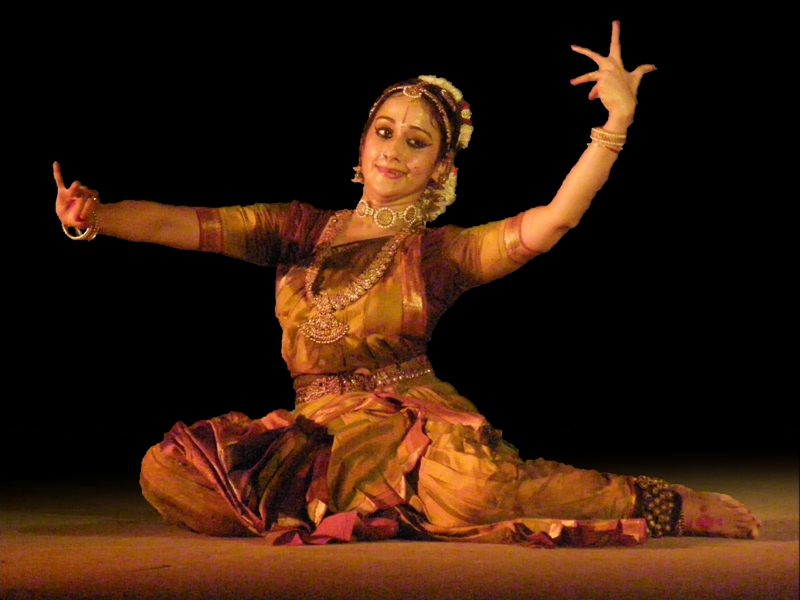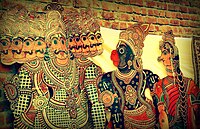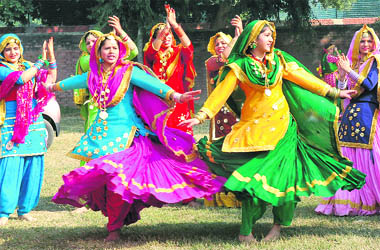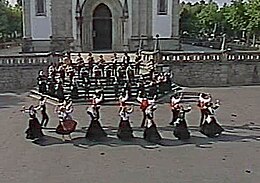ALL DANCE FORMS OF ALL STATES IN INDIA
1.ANDHRA PRADESH
The Dance forms of Andhra Pradesh take on a wide variety of colors, costumes, and types; and involve different settings and musical instruments. Andhra Pradesh is a state in southern India.
Burra refers to the tambura, a musical instrument played by the main storyteller. The main performer narrates a story, plays music and dances to it. The co-performers plays drums and addresses him constantly and enrich certain events in the story with their short sentences.
A very old form of dance in the state of Andhra Pradesh that has a
lot of religious significance attached to it; that is Veeranatyam. This
fascinating kind of dance form is also known as Veerangam and
Veerabhadra Nrityam. The term ‘Veera’ literally means brave. Thus as the
name of the dance form suggests it is the dance of the brave.
The illustration of Veeranatyam is found in the Hindu Mythology. Once Lord Shiva’s wife, Sati Devi was humiliated at a function. This made the Shiva-the God of destruction, furious. Lord Shiva, outraged at the humiliation met by his consort, Lord Shiva picked out a relic out of His hair or ‘Jatajuta’, which created Veerabhadra. He is believed to have portrayed out His extreme anger by performing a vigorous dance; thus justifying the name Veeranatyam. It was the dance of ‘Pralayam’ or Destruction.
The angry destructive Shiva or the ‘Pralayankar’ in the ferocity of rage tarnished the ‘Dakshayagna Vatika’, the place where the function was held.
The Veerabhadriya (Veeramusti community, changed its name recently from Veeramusti to Veerabhadriya) which claims to be the descendant of Veerabhadra, performs this vigorous dance with instruments like Tambura, Soolam, Dolu, Tasha and Veeranam usually at Draksharamam in East Godavari District of Andhra Pradesh, which is believed to be Dakshavatika, the birthplace of Veerabhadra
Natyam or Veerabhadra Natyam is performed by men in Hyderabad, East and West Godavari, Kurnool, Anantapur, Warangal and Khammam.
The first stage is the holding of "Veerabhadra Pallem", a huge plate carried from the palms to the elbows bearing a camphor fire. The dance goes on vigorously to the tempo of several percussion instruments until the fire is extinguished. Part of this ceremony consists of the ‘Khadgalu’ recital, where a pujari brandishes a long sword representing that of Veerabhadra.
The second stage lies in holding a long consecrated pole, marked with Vibhuti (sacred ash) representing the ‘Dhwaja Sthamba’ of the Lord with bells tied to the top.
tied to the top.
In the third stage the performers dance with spears and tridents pierced into their ankles, hands and tongue. This is called ‘Narasam’. The dancers are dressed in colorful knee-length dhotis secured by waist-sashes smeared with vibhuti all over their body. The main percussion instrument is the ‘Veeranam’ or ‘war-drum’.
Veeranatyam initially started as a ritual that was performed in all the Shiva or the shaivite temples in honour of Lord Shiva. At present, the followers of Veerabhadra mostly perform this form of performing arts. The community is known as Veeramusti community in the state of Andhra Pradesh.
Dressed in colorful ‘Dhotis’ and ‘Dattis’ the dancers perform Veerabhadra. Musical and rhythmic instruments like Dolu, Thasha, Veernam, Thambura and Soolam are used while the dance is being performed. To the rhythm of drumbeats, the dancers perform the dance of destruction. Long steps and dexterous hand movements are required for performing Veeranatyam. Draksharama in East Godavari district specially witnesses this dance form.
Veerabhadra dancer holds veera khadgam (sword) dances in synchronisation to words called 'Dhandakas' chanted by the other dancers beating simultaneously veerabhadra pallem, which is similar to war cry to challenge enemy, veerabhadra dance is very furious and expresses high degree of emotions.
A typical folk dance form, popular in Tanuku of West Godavari District of Andhra Pradesh, Butta Bommalu which literally means basket toys are made of wood-husk, dry grass and cow dung.
Each dancer wears a different mask over the head and shoulders
enlarging the scope of the performer and dances to a non-verbal rhythm
which adds colour to the movements.
Tholu Bommalata is a form of puppetry which originated in the South Indian state of Andhra Pradesh. [1]
It mainly depicts episodes from the epics. Puppets are large with
jointed waist, shoulders, elbows and knees. The classical music of the
region influences the music played in the show.
Made of goatskin, a tambourine-like
drum is beaten with sticks creating a rhythm that is softened only by
the ankle bells that the 16 to 20 dancers wear. Part of a Telangana
custom which sees the Dappu dancers at the front of any procession,
whether it be for jataras, festivals or marriages, this is truly a
celebration of the percussive powers of dance. This lively art form
hails from Nizamabad District. The performers wear colorful make-up and even more colorful costumes dance to the musical patterns set by cymbals, tabla and a harmonium. Mythological themes are usually enacted and the audience are the rurals.
Popular in Srikakulam and Vizianagaram Districts, this is a devotional dance which invokes the Rain God with its vigour, rhythm and tempo.
Also performed during festivals, the dance sees 15 to 20 vibrant
artists with drums around their necks creating mesmerising beats and
heart-stopping acrobatics
Associated with daily tasks harvesting, planting, sowing etc., the Lambadi is performed by the banjaras,
a semi-nomadic tribe seen all over Andhra Pradesh. Costumes embroidered
with glass beads and mirrors, ornate jewellery, ivory bangles, brass
anklets and a natural rhythm make this dance a colourful exposition of
joy which is the highlight of many a festive occasion
The folk festival of Bonalu
in the Telangana region brings with it celebrations which see the
colourfully dressed female dancers balancing pots (Bonalu), step to the
rhythmic beats and tunes in praise of the village deity Mahankali. Male
dancers called Potharajus precede the female dancers to the temple
lashing whips and neem leaves adding colour to the festivity.
DHIMSA:-

Dhimsa dance is a dance of young and old, men and women of Valmiki, Bagata, Khond and Kotia tribes living in the enchanting Araku Valley in the hilly tracts of Vishakhapatam district. A monthly magazine is published by the name of Dhimsa in [Telugu language] Tribals dance during the months of Chaitra i.e. March/April, on weddings and other festivities. During the festivals dancers of one village visit the other to participate in the dance and join the community feast. Such dances are known as “Sankidi Kelbar”. The unique feature of Dhimsa dance is that it chanalises friendship and fraternity between the people of different villages. This being traditionally a tribal dance, the women folk attired in typical tribal dress and ornaments dance in group to the tune of Mori, Kiridi, Tudumu, Dappu and Jodukommulu.
Dhimsa had branched off to eight different categories of dances. Boda Dimsa is a worship dance in honour of village goddess. Men on the right and women on the left form two rows and hold one another firmly in their hands the backs. The first man in the right row with a bunch of peacock feathers in hand in rhythmical steps takes the lead while the last person in the left row joins him. Then all dancers to the sounds of anklets move zigzag in a serpent dance in a circle crying “Hari” and “Hui” return to the rows. In Gunderi dimsa or Usku Dimsa a male dancer while singing sends invitation to the females to dance with him. Thereafter, the male and female with firm steps move forward and backward stride in a circle. In Goddi Beta Dimsa the dancers bending forward and rising up with a swing go about twenty-five steps and return in the same manner four to five times. Potar-Tola Dimsa dance symbolizes the picking up leaves. Half of the dancers stand side by side in a row, while the rest stand behind the first row in same manner and keep their hands on shoulders of dancers standing before. Turning their heads to right and left the two rows march forward and backward. Bhag Dimsa is a dance of art as to how to escape from a tigers attack. Half of the dancers form a circle holding hand in hand. They stand on their toes, bowing and raising their heads. Moving round swiftly, the rest enter the circle and form a “serpent Coil”. This is repeated several times. Natikari Dimsa is a solo dance danced by the Valmikis on Dewali festival in particular. Kunda Dimsa is dance where the dancers push each other with their shoulders while swinging rhythmically. Baya Dimsa dance is the dance of tribal magician when he is possessed by the village goddess. All the villagers with their hands bowed down imitate the “Ganachari”. This continues till the magician returns to normalcy Dimsa dances exhibit community unity without discrimination. These dance forms essentially amplifying their ways of life belong to their cultural heritage. Even though things have changed much, yet the hillmen had retained their traditions unspoilt. Though their dances cannot be included into any classical forms, yet they conform to the rhythm of either “Aditala” or “Rupakatala”.
'Kolatam', or the stick dance, is one of the most popular dance narratives in Andhra Pradesh.
It is also called as Kolannalu or Kolkolannalu. A rural art usually
performed during village festivals, kolatam is a combination of rhythmic
movements, songs and music. It is known as Dandia ras in Gujarat, Garbha in Rajasthan,
etc. The Kolatam group comprises dancers in the range of 8 to 40. In
kolatam, performed by 8 to 40 artists grouped in pairs, The stick
provides the main rhythm. The artists led by the leader move into two
circles, the inner circle receiving the strikes while the outer circle
delivering them. Kolatam offers a great variety of entertainment to the
spectators as well as the participants.
Kolatam is also called Kolanna in the Prakasam district of Andhra Pradesh state.
2 ARUNACHAL PRADESH
A folk dance of Sherdukpens, a small community of West Kameng District of Arunachal Pradesh,
Bardo Chham depicts the victory of good over evil. The dance has an
interesting background. According to the local beliefs, forces - both
good and evil, rule mankind. The folks believe that in one year, twelve
different types of stupid things, representing evil forces, appear each
month and get together. The sherdukpens mask themselves representing the
different animals and dance to the accompaniment of drums and cymbals
as an act of fighting the evil forces.
3 ANDAMAN AND NICOBAR
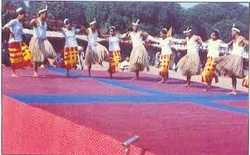
NICOBARESE DANCE
Nicobarese dance is performed by Nicobarese who live in the Island of Car Nicobar. Among the many fascinating tribal groups that inhabit the islands of Andaman and Nicobar, Nicobarese is the only tribe who has lived in isolation and have unique traditional tribal ways. They are not even remotely influenced by modern civilisation and education.
The Festive Rituals
Colourful tribal festivities are still observed in Nicobar Islands . The Nicobarese dance is performed during the "Ossuary Feast or the Pig Festival", which is dedicated to the departed head of the family. The occasion is observed with nightlong dancing in full moon light, under waving coconut palms. The dancers, dressed in coconut fronds, step gracefully in time, to traditional songs. The feast is followed by a pig fight in the morning.
4 ASSAM
¤ Bihu Dance

This form of dance is the most popular folk dance in Assam and is also a part of the life known as Assamese life. The folk dance cuts through all the religious, caste and class barriers of the different kinds of people living in Assam.
Bihu Dance is performed during the festival and the festival is celebrated thrice annually with their respective common name. Rongali , the biggest festival of Assam, is celebrated in the mid of April. Bhogali is celebrated during mid of January and Kangali is done in the mid of October.
When the festival arrives, the young men and girls who are performers gather during day time in the open. These performers dance together but are not paired together and form in lines when they dance. The music played at this dance are drums and pipes and the performers sing of love during the act. The pattern which the performers follow during the dance is the circle or the parallel rows. The dancers sway their hips, take brisk steps and fling and flip their hands when the dance progresses. The traditional dress worn consist of Dhoti, Gamocha, Chadar and Mekhala (Indian clothes).
¤ Sattriya Dance
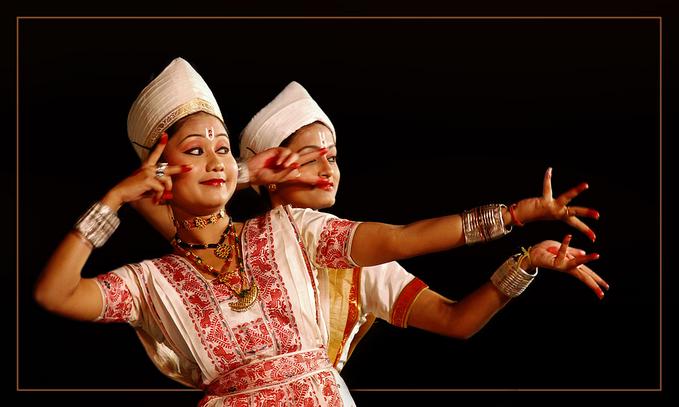
Sattriya Dance is the art form that epitomises the dance culture of Assam. It was recently recognised as a classical dance form and it is among the finest of the classical dances of India. An Assamese religious reformer, Sri Shankardev, preached a unique philosophy of a new Vaishnavism and from it grew the particular dance. The word, 'sattriya' comes from 'sattra'-monasteries which are established by the reformer.
Without altering its basic structure of the dance, the style has been going through an refinement. The performer can give a solo performance against a repertoire owing from the fact that it is represented in a lyrical and graceful style. The movements of the hand and body are very slow and gentle and it communicate tales from the legends of Lord Vishnu and from the life of Lord Krishna. The music in the dance mostly depend upon the cymbals, supporting raga and other songs.
5 BIHAR
Over thousands of years various traditional dance forms have evolved in Bihar. The folk dance tradition in Bihar can be divided into three groups. First, the dance performed during poetry performance. The second stream is those of the tribal people who are closer to mother earth and their dances are heavily influenced by indigenous development. The third stream relates to the other regions of south Bihar. Most of the folk dances are religious in nature, in which, gods and goddesses are invoked through dance, performed to the rhythm of folk songs and music.
Bidesia

Bidesia is the most popular folk dance of Bihar people. The dance is said to have originated in the 20th century. It is a folk theatre form that is prevalent in the Bhojpuri-speaking regions of Bihar. Bhikari Thakur is believed to be the father of this dance style. He raised conflicting issues prevailing in society. Conflicting trends between rich and poor, upper class and lower class, upper caste and lower caste, urban and poor dwellers etc were his themes. He used dance as a form to put his views onto ground and among people.
Biraha songs combined with dance become an effective medium. Bidesia is a dance version of Biraha songs. Biraha songs are portrayal of pain of the women who are left alone behind by their men, away from home. Males play the roles of female in Bidesiya dance and for the purpose; they wear artificial long hair and dhoti. Despite the fact that many new modes of
Paika

Another popular dance form of Bihar is Paika. The dance reminds us of infantry and its agility, courage, and excitement. The dance is popular particularly in the Mayurbhanj region. A flat ground is essential for its performance. This dance displays the skills & the ability of the dancers to handle these weapons. The dance reaches its climax with the fast beats produced by `Mandal`. Performers wear colorful turbans and tight dhotis and stand in two rows. Holding the wooden swords and shields in their hands, warriors engage in a fierce mock combat.
Jhijhian

Jhijhian dance is another dance style popular in Bihar. This is a ritualistic dance performed during no-rain time and aims at making the God of rain happy. The dance is accompanied by a song which is full of prayers to Lord Indra, the rain God. The participants of the dance include a lead singer, harmonium player, a flute player, and a dholak player. This is woman only dance show.
Kajari Dance
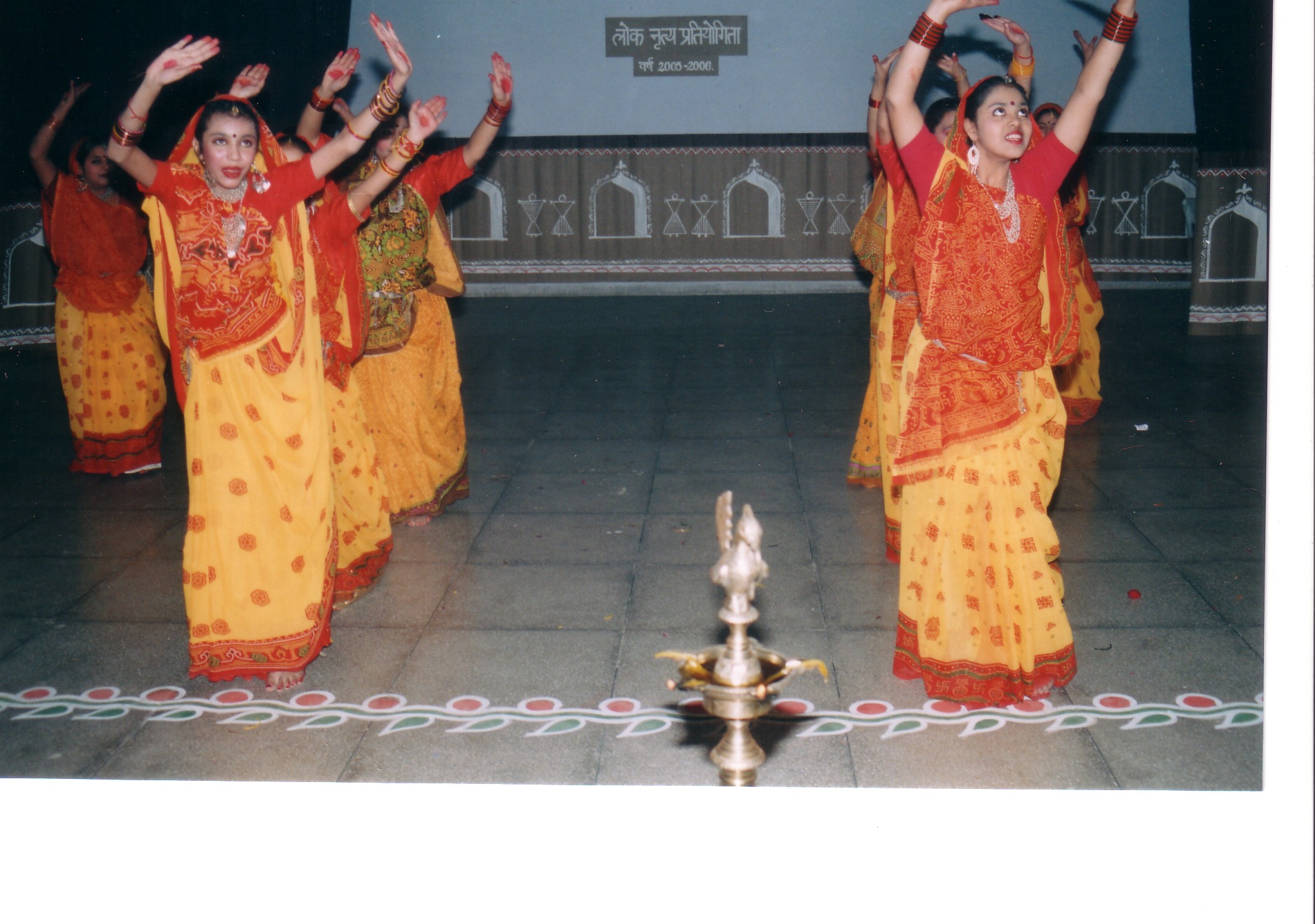
Kajari songs are basically sung during monsoon season. The dance form called Kajari Dance accompanies these songs. The dance starts in the month of ‘Shravan’ or the starting of the monsoon season every year and lasts for the entire duration of rain. These songs describe how wonderful earth has become due to rain and how happy and pleasant people are. These songs, combined with dance, are showcase of rich culture and tradition of Bihar.
6 CHANDIGARH
Dhamal is a special folk dance that is performed by men during the
harvest festival. This dance form begins with one person starting it
while the other people will just follow the steps and enjoy this
harvest festival in a unique way. This dance is incomplete without the
sticks which is also known as shuntis and wrapped with tinsel from both
ends. All men collect together in a semi circle and seek blessings of
Lord Ganesh followed by Goddess Bhavani, Lord Brahma, Lord Vishnu and
Lord Mahesh.
Another very popular dance form is Bhangra. It is not only
popular in Chandigarh and India but also in other countries. This dance
form is considered to be the king of all dances thus combining many
other dances like hip hop, international dance form and reggae. Bhangra
is usually done with a Dhol that is played by one person while others
dance to its tune. A scintillating atmosphere is created all around and
you will surely love how people enjoy them. It is the best dance
suitable for any occasion like festivals, weddings and harvest
occasions.
Bhangra is known for its fast movements that make the performance more energetic. Unlike Dhamal which is done only be men, Bhangra can be done by males as well as females. Different kinds of steps are performed one after the other in such a way that everyone loves it. It is quite difficult to maintain the same energy throughout the music but the enthusiasm of people is definitely worth seeing. Punjabi’s are really fluent in this dance form and can dance for any number of hours.
The next dance form which is highly popular is Giddha. Being a
traditional folk dance, it is a great way to show your feeling and
portray your happiness. The dance begins with slow movements but as the
tempo goes up, the movements become fast as well as vigorous. It is a
complete entertainment for people and you can explore such dance
performances exclusively in Chandigarh and other regions of Punjab.
Giddha is not all about dancing but it also includes enacting the
verses to impress the people. This is usually done by women while men
dance to the tunes of the Dhol. Giddha is performed in a circle with
men, women and kids moving in a circle and doing their steps. It is
definitely a fun filled performance and a great way to enjoy yourself.
Boliyan is also a popular part of Giddha which is really loved by
people.
7 CHATTISGARH
Panthi, the folk dance of the Satnami community, has religious
overtones. Panthi is performed on Maghi Purnima, the anniversary of the
birth of Guru Ghasidas.
The dancers dance around a jaitkhamb set up for the occasion, to songs
eulogizing their spiritual head. The songs reflect a view of nirvana, conveying the spirit of their guru's renunciation and the teachings of saint poets like Kabir,
Ramdas and Dadu. Dancers with bent torsos and swinging arms dance,
carried away by their devotion. As the rhythm quickens, they perform
acrobatics and form human pyramids.[44]
In Bilaspur, the Rawat Nach Mahotsav folk dance festival is organized annually since 1978. Tens of hundreds of Rawat dancers from remote areas participate.[48]
Tribal groups like Gonds, the Baigas and the Oraons in Chhattisgarh
have Karma dance as part of their culture. Both men and women arrange
themselves in two rows and follow the rhythmic steps, directed by the
singer group. The Karma tribal dance marks the end of the rainy season
and the advent of spring season
8 DADRA AND NAGAR HAVELI
Dhol Dance
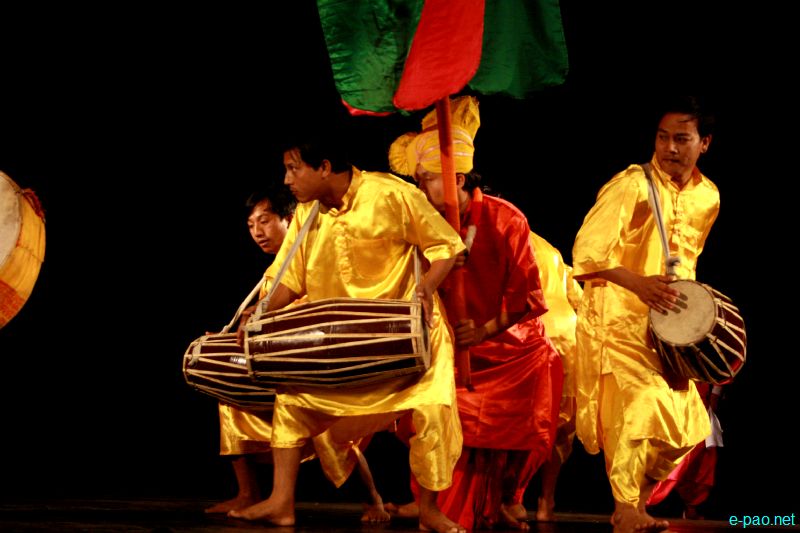 One of the most loved folk dances of Dadra and
Nagar Haveli, the Dhol dance is performed during the harvest season. It
is especially popular among the people belonging to the Varli and Kokna
tribes who perform it at night from September to March to please the
presiding deities of the village. Dressed in beautiful colourful clothes
these people dance to the tunes of timkis and dhols. Human pyramids are
formed and various intricate acrobatic steps are performed as a part of
this dance form.
One of the most loved folk dances of Dadra and
Nagar Haveli, the Dhol dance is performed during the harvest season. It
is especially popular among the people belonging to the Varli and Kokna
tribes who perform it at night from September to March to please the
presiding deities of the village. Dressed in beautiful colourful clothes
these people dance to the tunes of timkis and dhols. Human pyramids are
formed and various intricate acrobatic steps are performed as a part of
this dance form.
Bohada Dance
 This folk dance is performed to show gratitude to
the Gods and Goddesses of the village. People from different tribes
dress up in vibrant attires and gather to perform this beautiful dance.
An inseparable part of their lives, the dance is also considered most
sacred as it is performed for the deities. The enthusiasm and the
synchronization of the dancers performing the Bohada dance are
definitely worthy of appreciation.
This folk dance is performed to show gratitude to
the Gods and Goddesses of the village. People from different tribes
dress up in vibrant attires and gather to perform this beautiful dance.
An inseparable part of their lives, the dance is also considered most
sacred as it is performed for the deities. The enthusiasm and the
synchronization of the dancers performing the Bohada dance are
definitely worthy of appreciation.
Tarpa Dance
 This dance forms a part of the daily lives of the
people here. They don’t have to wait for special occasions to perform
it; it is performed in their routine lives though several people from
different tribes are especially seen performing it during the festival
of harvest. It is especially popular among the Kolis, Varli and Kokna.
The dance is performed in a group where there is a leader who taps the
ground with a decked up stick and the others hold each other around
their waists and move around the musician. They all dance joyously to
the tunes of the Tarpa, a wind instrument made of gourd and bamboo
sticks.
This dance forms a part of the daily lives of the
people here. They don’t have to wait for special occasions to perform
it; it is performed in their routine lives though several people from
different tribes are especially seen performing it during the festival
of harvest. It is especially popular among the Kolis, Varli and Kokna.
The dance is performed in a group where there is a leader who taps the
ground with a decked up stick and the others hold each other around
their waists and move around the musician. They all dance joyously to
the tunes of the Tarpa, a wind instrument made of gourd and bamboo
sticks.
Gherria Dance
 Another
popular folk dance Gherria is performed by the people belonging to the
Dubla clan mostly during the Diwali festival in the months of October
and November. This is a group dance where in there is a leader who
guides the rest of the dancers. While all the dancers are dressed up in
colourful attires the leader is dressed very elaborately with a
beautiful ornate headdress and holds a few peacock feathers in his
hands. The male dancers hold two small sticks and strike it against each
other every now and then during the performance just as in a dandiya
dance while one of the dancers holds a long stick.
Another
popular folk dance Gherria is performed by the people belonging to the
Dubla clan mostly during the Diwali festival in the months of October
and November. This is a group dance where in there is a leader who
guides the rest of the dancers. While all the dancers are dressed up in
colourful attires the leader is dressed very elaborately with a
beautiful ornate headdress and holds a few peacock feathers in his
hands. The male dancers hold two small sticks and strike it against each
other every now and then during the performance just as in a dandiya
dance while one of the dancers holds a long stick.
The musical instruments played during different folk dances are mostly crafted by the tribal people. Wood, bamboo, leather and gourd are among the materials used for crafting these.
9 DAMAN AND DIU
Mando Dance

Mando or
Manddo (Konkanimānḍô) is a musical form that evolved during the 19th and 20th century among Goan Catholics of Goa,India. It represents the meeting point of Indian and western musical traditions. The music has elements of both Indian and western culture. The males wear formal coats, showing Portuguese influence, while females wear a unique Indian costume (bazu torop or pano baju). The ceremonial torhop-baz worn during the mando dance was of velvet or silk, red, blue or green in colour, embroidered with gold (rarely with silver) threads.
Vira Dance
1.ANDHRA PRADESH
The Dance forms of Andhra Pradesh take on a wide variety of colors, costumes, and types; and involve different settings and musical instruments. Andhra Pradesh is a state in southern India.
Contents
- 1 Kuchipudi
- 2 Vilasini Natyam
- 3 Burrakatha
- 4 Veeranatyam
- 5 Butta bommalu
- 6 Tholu Bommalata
- 7 Dappu
- 8 Tappeta Gullu
- 9 Lambadi
- 10 Bonalu
- 11 Kolatam
Kuchipudi
Main article: Kuchipudi
- Shishyas and gurus were Kuchipudi Brahmins like Lakshmi Narayan Shastri and Chinta Krishna Murti who excelled in roles like Satyabhama in Bhamakalapam; later gurus include Vedantam Chinna Satyam. Today both group performances and solo performances are popular but experimentation is always being done with the choreography.
Vilasini Natyam
Main article: Vilasini Natyam
Vilasini Natyam is dance tradition of deva dasis in Andhra
Pradesh. It faced near extinct after anti-deva dasi act and fortunately
revived by few remaining dancers. It is yet to receive Indian Classial Dance status.Burrakatha
Main article: Burra katha
Burrakatha is the new name (twentieth century) for the theatre known
as Jangam Katha. The jangams were wandering Shiva worshippers.Burra refers to the tambura, a musical instrument played by the main storyteller. The main performer narrates a story, plays music and dances to it. The co-performers plays drums and addresses him constantly and enrich certain events in the story with their short sentences.
Veeranatyam
The illustration of Veeranatyam is found in the Hindu Mythology. Once Lord Shiva’s wife, Sati Devi was humiliated at a function. This made the Shiva-the God of destruction, furious. Lord Shiva, outraged at the humiliation met by his consort, Lord Shiva picked out a relic out of His hair or ‘Jatajuta’, which created Veerabhadra. He is believed to have portrayed out His extreme anger by performing a vigorous dance; thus justifying the name Veeranatyam. It was the dance of ‘Pralayam’ or Destruction.
The angry destructive Shiva or the ‘Pralayankar’ in the ferocity of rage tarnished the ‘Dakshayagna Vatika’, the place where the function was held.
The Veerabhadriya (Veeramusti community, changed its name recently from Veeramusti to Veerabhadriya) which claims to be the descendant of Veerabhadra, performs this vigorous dance with instruments like Tambura, Soolam, Dolu, Tasha and Veeranam usually at Draksharamam in East Godavari District of Andhra Pradesh, which is believed to be Dakshavatika, the birthplace of Veerabhadra
Natyam or Veerabhadra Natyam is performed by men in Hyderabad, East and West Godavari, Kurnool, Anantapur, Warangal and Khammam.
The first stage is the holding of "Veerabhadra Pallem", a huge plate carried from the palms to the elbows bearing a camphor fire. The dance goes on vigorously to the tempo of several percussion instruments until the fire is extinguished. Part of this ceremony consists of the ‘Khadgalu’ recital, where a pujari brandishes a long sword representing that of Veerabhadra.
The second stage lies in holding a long consecrated pole, marked with Vibhuti (sacred ash) representing the ‘Dhwaja Sthamba’ of the Lord with bells
 tied to the top.
tied to the top.In the third stage the performers dance with spears and tridents pierced into their ankles, hands and tongue. This is called ‘Narasam’. The dancers are dressed in colorful knee-length dhotis secured by waist-sashes smeared with vibhuti all over their body. The main percussion instrument is the ‘Veeranam’ or ‘war-drum’.
Veeranatyam initially started as a ritual that was performed in all the Shiva or the shaivite temples in honour of Lord Shiva. At present, the followers of Veerabhadra mostly perform this form of performing arts. The community is known as Veeramusti community in the state of Andhra Pradesh.
Dressed in colorful ‘Dhotis’ and ‘Dattis’ the dancers perform Veerabhadra. Musical and rhythmic instruments like Dolu, Thasha, Veernam, Thambura and Soolam are used while the dance is being performed. To the rhythm of drumbeats, the dancers perform the dance of destruction. Long steps and dexterous hand movements are required for performing Veeranatyam. Draksharama in East Godavari district specially witnesses this dance form.
Veerabhadra dancer holds veera khadgam (sword) dances in synchronisation to words called 'Dhandakas' chanted by the other dancers beating simultaneously veerabhadra pallem, which is similar to war cry to challenge enemy, veerabhadra dance is very furious and expresses high degree of emotions.
Butta bommalu
Tholu Bommalata
Dappu
Tappeta Gullu
Lambadi
Bonalu
DHIMSA:-

Dhimsa dance is a dance of young and old, men and women of Valmiki, Bagata, Khond and Kotia tribes living in the enchanting Araku Valley in the hilly tracts of Vishakhapatam district. A monthly magazine is published by the name of Dhimsa in [Telugu language] Tribals dance during the months of Chaitra i.e. March/April, on weddings and other festivities. During the festivals dancers of one village visit the other to participate in the dance and join the community feast. Such dances are known as “Sankidi Kelbar”. The unique feature of Dhimsa dance is that it chanalises friendship and fraternity between the people of different villages. This being traditionally a tribal dance, the women folk attired in typical tribal dress and ornaments dance in group to the tune of Mori, Kiridi, Tudumu, Dappu and Jodukommulu.
Dhimsa had branched off to eight different categories of dances. Boda Dimsa is a worship dance in honour of village goddess. Men on the right and women on the left form two rows and hold one another firmly in their hands the backs. The first man in the right row with a bunch of peacock feathers in hand in rhythmical steps takes the lead while the last person in the left row joins him. Then all dancers to the sounds of anklets move zigzag in a serpent dance in a circle crying “Hari” and “Hui” return to the rows. In Gunderi dimsa or Usku Dimsa a male dancer while singing sends invitation to the females to dance with him. Thereafter, the male and female with firm steps move forward and backward stride in a circle. In Goddi Beta Dimsa the dancers bending forward and rising up with a swing go about twenty-five steps and return in the same manner four to five times. Potar-Tola Dimsa dance symbolizes the picking up leaves. Half of the dancers stand side by side in a row, while the rest stand behind the first row in same manner and keep their hands on shoulders of dancers standing before. Turning their heads to right and left the two rows march forward and backward. Bhag Dimsa is a dance of art as to how to escape from a tigers attack. Half of the dancers form a circle holding hand in hand. They stand on their toes, bowing and raising their heads. Moving round swiftly, the rest enter the circle and form a “serpent Coil”. This is repeated several times. Natikari Dimsa is a solo dance danced by the Valmikis on Dewali festival in particular. Kunda Dimsa is dance where the dancers push each other with their shoulders while swinging rhythmically. Baya Dimsa dance is the dance of tribal magician when he is possessed by the village goddess. All the villagers with their hands bowed down imitate the “Ganachari”. This continues till the magician returns to normalcy Dimsa dances exhibit community unity without discrimination. These dance forms essentially amplifying their ways of life belong to their cultural heritage. Even though things have changed much, yet the hillmen had retained their traditions unspoilt. Though their dances cannot be included into any classical forms, yet they conform to the rhythm of either “Aditala” or “Rupakatala”.
Kolatam
Kolatam is also called Kolanna in the Prakasam district of Andhra Pradesh state.
2 ARUNACHAL PRADESH
Bardo Chham
3 ANDAMAN AND NICOBAR

NICOBARESE DANCE
Nicobarese dance is performed by Nicobarese who live in the Island of Car Nicobar. Among the many fascinating tribal groups that inhabit the islands of Andaman and Nicobar, Nicobarese is the only tribe who has lived in isolation and have unique traditional tribal ways. They are not even remotely influenced by modern civilisation and education.
The Festive Rituals
Colourful tribal festivities are still observed in Nicobar Islands . The Nicobarese dance is performed during the "Ossuary Feast or the Pig Festival", which is dedicated to the departed head of the family. The occasion is observed with nightlong dancing in full moon light, under waving coconut palms. The dancers, dressed in coconut fronds, step gracefully in time, to traditional songs. The feast is followed by a pig fight in the morning.
4 ASSAM
¤ Bihu Dance

This form of dance is the most popular folk dance in Assam and is also a part of the life known as Assamese life. The folk dance cuts through all the religious, caste and class barriers of the different kinds of people living in Assam.
Bihu Dance is performed during the festival and the festival is celebrated thrice annually with their respective common name. Rongali , the biggest festival of Assam, is celebrated in the mid of April. Bhogali is celebrated during mid of January and Kangali is done in the mid of October.
When the festival arrives, the young men and girls who are performers gather during day time in the open. These performers dance together but are not paired together and form in lines when they dance. The music played at this dance are drums and pipes and the performers sing of love during the act. The pattern which the performers follow during the dance is the circle or the parallel rows. The dancers sway their hips, take brisk steps and fling and flip their hands when the dance progresses. The traditional dress worn consist of Dhoti, Gamocha, Chadar and Mekhala (Indian clothes).
¤ Sattriya Dance

Sattriya Dance is the art form that epitomises the dance culture of Assam. It was recently recognised as a classical dance form and it is among the finest of the classical dances of India. An Assamese religious reformer, Sri Shankardev, preached a unique philosophy of a new Vaishnavism and from it grew the particular dance. The word, 'sattriya' comes from 'sattra'-monasteries which are established by the reformer.
Without altering its basic structure of the dance, the style has been going through an refinement. The performer can give a solo performance against a repertoire owing from the fact that it is represented in a lyrical and graceful style. The movements of the hand and body are very slow and gentle and it communicate tales from the legends of Lord Vishnu and from the life of Lord Krishna. The music in the dance mostly depend upon the cymbals, supporting raga and other songs.
5 BIHAR
Over thousands of years various traditional dance forms have evolved in Bihar. The folk dance tradition in Bihar can be divided into three groups. First, the dance performed during poetry performance. The second stream is those of the tribal people who are closer to mother earth and their dances are heavily influenced by indigenous development. The third stream relates to the other regions of south Bihar. Most of the folk dances are religious in nature, in which, gods and goddesses are invoked through dance, performed to the rhythm of folk songs and music.
Bidesia

Bidesia is the most popular folk dance of Bihar people. The dance is said to have originated in the 20th century. It is a folk theatre form that is prevalent in the Bhojpuri-speaking regions of Bihar. Bhikari Thakur is believed to be the father of this dance style. He raised conflicting issues prevailing in society. Conflicting trends between rich and poor, upper class and lower class, upper caste and lower caste, urban and poor dwellers etc were his themes. He used dance as a form to put his views onto ground and among people.
Biraha songs combined with dance become an effective medium. Bidesia is a dance version of Biraha songs. Biraha songs are portrayal of pain of the women who are left alone behind by their men, away from home. Males play the roles of female in Bidesiya dance and for the purpose; they wear artificial long hair and dhoti. Despite the fact that many new modes of
entertainment
has come up, Bidesia still has its charm amongst Biharis. Paika

Another popular dance form of Bihar is Paika. The dance reminds us of infantry and its agility, courage, and excitement. The dance is popular particularly in the Mayurbhanj region. A flat ground is essential for its performance. This dance displays the skills & the ability of the dancers to handle these weapons. The dance reaches its climax with the fast beats produced by `Mandal`. Performers wear colorful turbans and tight dhotis and stand in two rows. Holding the wooden swords and shields in their hands, warriors engage in a fierce mock combat.
Jhijhian

Jhijhian dance is another dance style popular in Bihar. This is a ritualistic dance performed during no-rain time and aims at making the God of rain happy. The dance is accompanied by a song which is full of prayers to Lord Indra, the rain God. The participants of the dance include a lead singer, harmonium player, a flute player, and a dholak player. This is woman only dance show.
Kajari Dance

Kajari songs are basically sung during monsoon season. The dance form called Kajari Dance accompanies these songs. The dance starts in the month of ‘Shravan’ or the starting of the monsoon season every year and lasts for the entire duration of rain. These songs describe how wonderful earth has become due to rain and how happy and pleasant people are. These songs, combined with dance, are showcase of rich culture and tradition of Bihar.
6 CHANDIGARH
Dhamal
Bhangra
Bhangra is known for its fast movements that make the performance more energetic. Unlike Dhamal which is done only be men, Bhangra can be done by males as well as females. Different kinds of steps are performed one after the other in such a way that everyone loves it. It is quite difficult to maintain the same energy throughout the music but the enthusiasm of people is definitely worth seeing. Punjabi’s are really fluent in this dance form and can dance for any number of hours.
Giddha
7 CHATTISGARH
Panthi
Pandwani
Pandavani is a folk ballad form performed predominantly in Chhattisgarh. It depicts the story of the Pandavas, the leading characters in the epic Mahabharata. The artists in the Pandavani narration consist of a lead artist and some supporting singers and musicians. There are two styles of narration in Pandavani, Vedamati and Kapalik. In the Vedamati style the lead artist narrates in a simple manner by sitting on the floor throughout the performance. The Kaplik style is livelier, where the narrator actually enacts the scenes and characters.[45]
Pandwani
Rawat Nacha
Rawat Nacha, the folk dance of cowherds, is a traditional dance of Yaduvanshis (clan of Yadu) as symbol of worship to Krishna from the 4th day of Diwali(Goverdhan Puja) till the time of Dev Uthani Ekadashi (day of awakening of the gods after a brief rest) which is the 11th day after Diwali according to the Hindu calendar . The dance closely resembles Krishna's dance with the gopis (milkmaids).[46][47]In Bilaspur, the Rawat Nach Mahotsav folk dance festival is organized annually since 1978. Tens of hundreds of Rawat dancers from remote areas participate.[48]
Raut Nacha
Soowa Nacha
Soowa or Suwa tribal dance in Chhattisgarh is also known as Parrot Dance. It is a symbolic form of dancing related to worship. Dancers keep a parrot in a bamboo-pot and form a circle around it. Then performers sing and dance, moving around it with clapping. This is one of the main dance form of tribal women of Chhattisgarh.[49]
Sua Nacha at Khudmudi Village, Chhattisgarh
Karma
8 DADRA AND NAGAR HAVELI
Dhol Dance
 One of the most loved folk dances of Dadra and
Nagar Haveli, the Dhol dance is performed during the harvest season. It
is especially popular among the people belonging to the Varli and Kokna
tribes who perform it at night from September to March to please the
presiding deities of the village. Dressed in beautiful colourful clothes
these people dance to the tunes of timkis and dhols. Human pyramids are
formed and various intricate acrobatic steps are performed as a part of
this dance form.
One of the most loved folk dances of Dadra and
Nagar Haveli, the Dhol dance is performed during the harvest season. It
is especially popular among the people belonging to the Varli and Kokna
tribes who perform it at night from September to March to please the
presiding deities of the village. Dressed in beautiful colourful clothes
these people dance to the tunes of timkis and dhols. Human pyramids are
formed and various intricate acrobatic steps are performed as a part of
this dance form.Bohada Dance
 This folk dance is performed to show gratitude to
the Gods and Goddesses of the village. People from different tribes
dress up in vibrant attires and gather to perform this beautiful dance.
An inseparable part of their lives, the dance is also considered most
sacred as it is performed for the deities. The enthusiasm and the
synchronization of the dancers performing the Bohada dance are
definitely worthy of appreciation.
This folk dance is performed to show gratitude to
the Gods and Goddesses of the village. People from different tribes
dress up in vibrant attires and gather to perform this beautiful dance.
An inseparable part of their lives, the dance is also considered most
sacred as it is performed for the deities. The enthusiasm and the
synchronization of the dancers performing the Bohada dance are
definitely worthy of appreciation.Tarpa Dance
 This dance forms a part of the daily lives of the
people here. They don’t have to wait for special occasions to perform
it; it is performed in their routine lives though several people from
different tribes are especially seen performing it during the festival
of harvest. It is especially popular among the Kolis, Varli and Kokna.
The dance is performed in a group where there is a leader who taps the
ground with a decked up stick and the others hold each other around
their waists and move around the musician. They all dance joyously to
the tunes of the Tarpa, a wind instrument made of gourd and bamboo
sticks.
This dance forms a part of the daily lives of the
people here. They don’t have to wait for special occasions to perform
it; it is performed in their routine lives though several people from
different tribes are especially seen performing it during the festival
of harvest. It is especially popular among the Kolis, Varli and Kokna.
The dance is performed in a group where there is a leader who taps the
ground with a decked up stick and the others hold each other around
their waists and move around the musician. They all dance joyously to
the tunes of the Tarpa, a wind instrument made of gourd and bamboo
sticks.Gherria Dance
The musical instruments played during different folk dances are mostly crafted by the tribal people. Wood, bamboo, leather and gourd are among the materials used for crafting these.
9 DAMAN AND DIU
Mando Dance
Mando or
Manddo (Konkanimānḍô) is a musical form that evolved during the 19th and 20th century among Goan Catholics of Goa,India. It represents the meeting point of Indian and western musical traditions. The music has elements of both Indian and western culture. The males wear formal coats, showing Portuguese influence, while females wear a unique Indian costume (bazu torop or pano baju). The ceremonial torhop-baz worn during the mando dance was of velvet or silk, red, blue or green in colour, embroidered with gold (rarely with silver) threads.
Vira Dance
The vira is a traditional dance fromPortugal.[1] It is most popular in theMinho region but is performed in every region.[2] It has a three-step rhythm which is very similar to a waltz, but it is faster and the couples dance front-to-front without holding hands.
Verdigao Dance
- The typical Portuguese regional folk dances of the territory include the Mando Dance, ViraDance, and the Verdigao in which happiness and the whole life style of the people of Diu is depicted. In these dances the clean roads, the delicious food and the traditions of Diu are described

